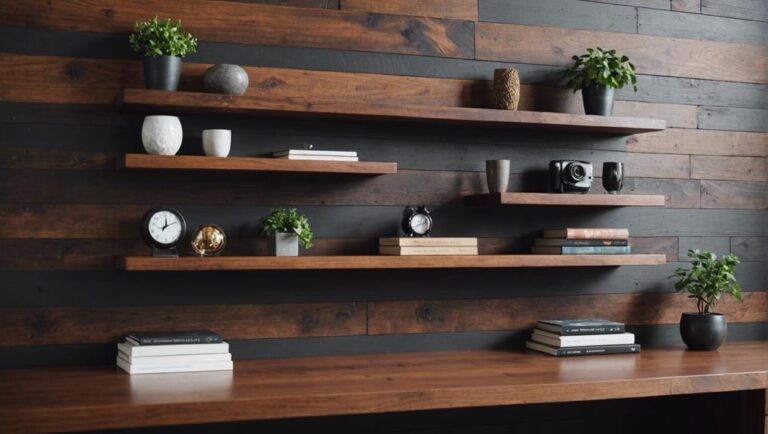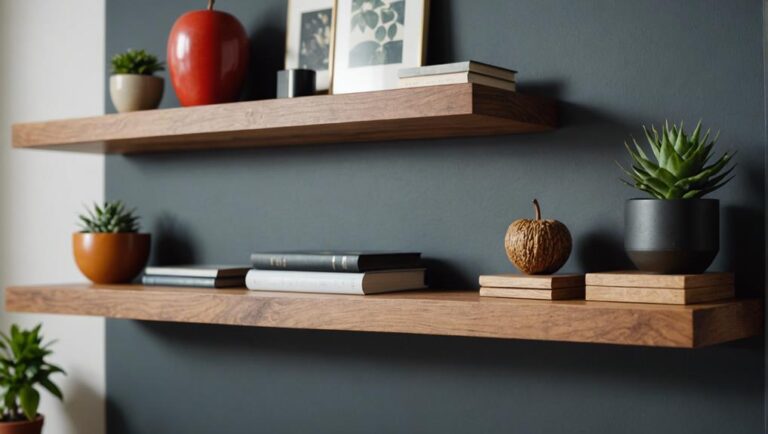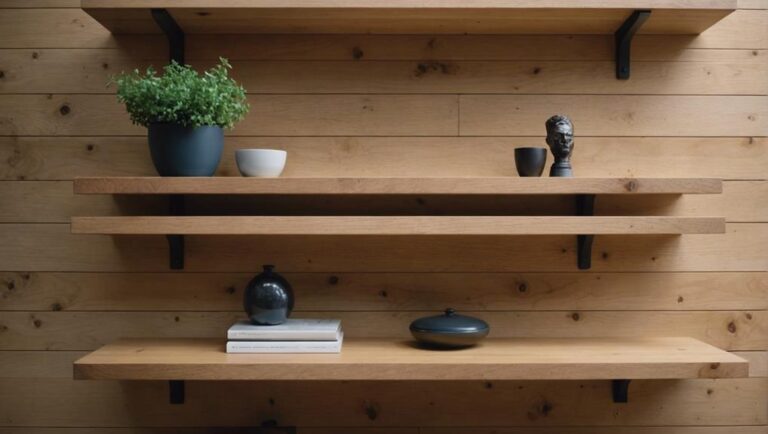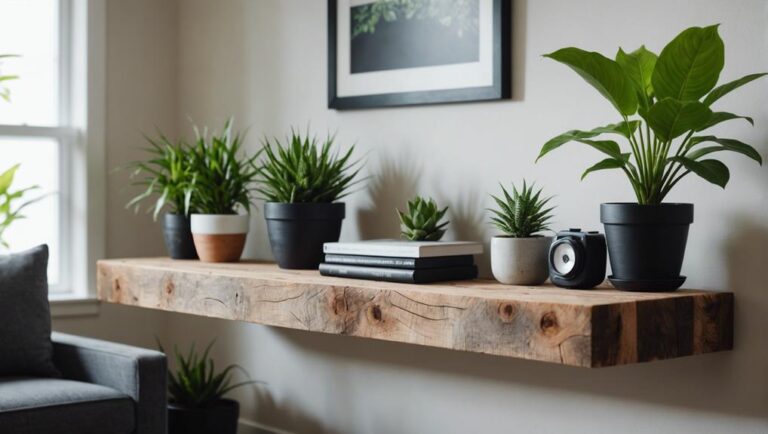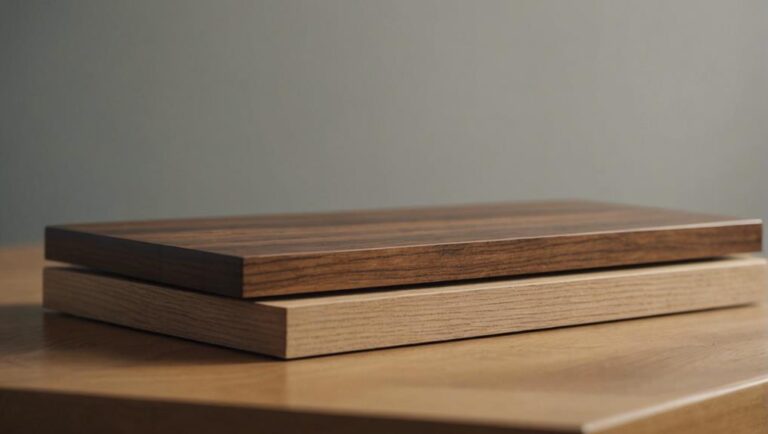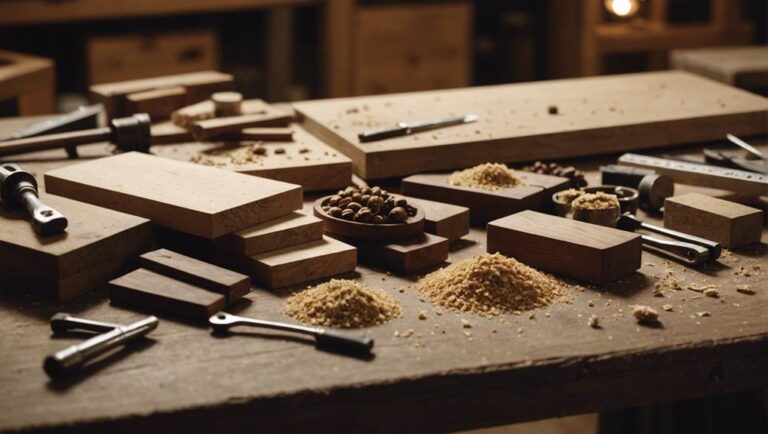Pros and Cons of Popular Wood Species for Floating Shelves
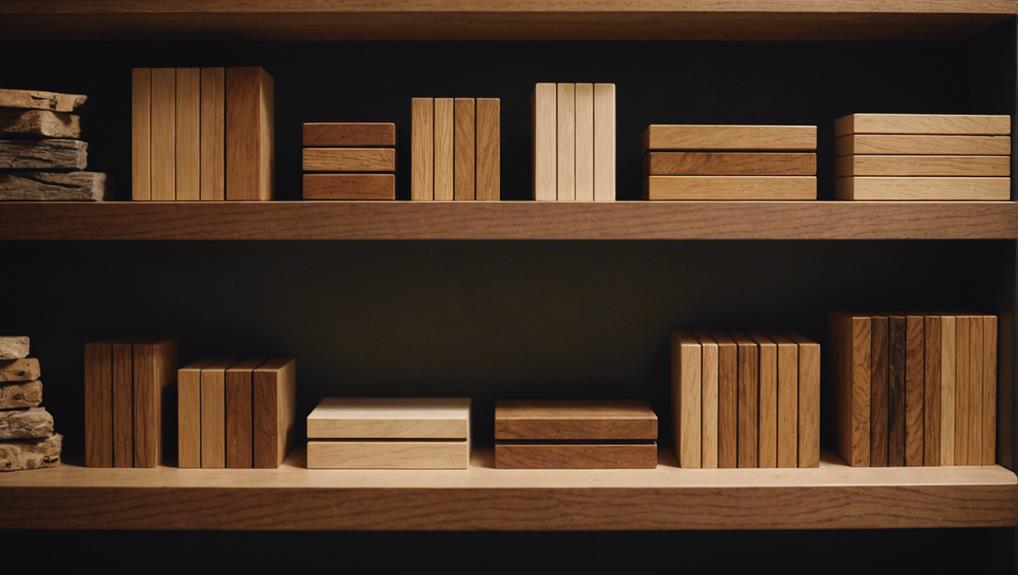
When choosing wood for floating shelves, consider the characteristics of each wood species. Oak is known for its durability and resistance to moisture, making it a reliable choice for long-lasting shelves.
Walnut, on the other hand, offers a unique grain pattern and elegant appearance, but it requires regular maintenance to preserve its beauty. Pine is budget-friendly and adds a rustic charm to your space, but it is prone to warping over time.
Mahogany boasts a luxurious hue that adds sophistication to any room and is highly durable, ensuring your shelves will last for years to come. Maple, a sturdy and cost-effective hardwood, is a practical option for those looking for both strength and affordability.
Ash is prized for its exceptional strength and shock resistance, making it a great choice for heavy-duty shelving projects. Hickory stands out for its exceptional strength and resistance to moisture, making it a reliable option for shelves in areas prone to humidity.
Birch is a versatile wood that is ideal for DIY projects, allowing you to customize your shelves according to your preferences. Cedar naturally repels insects, making it a suitable choice for outdoor or storage shelves.
Poplar, a lightweight and economical option, is a popular choice for those on a budget looking for a versatile wood species.
Each wood species has its unique advantages and potential drawbacks, so it's important to consider your specific needs and preferences when choosing the right wood for your floating shelves.
Key Takeaways
- Oak: Oak wood is renowned for its exceptional durability and resistance to moisture, making it a top choice for floating shelves. However, oak is heavier than other wood species and comes at a higher price point.
- Pine: If you're on a budget and looking for a wood species that is easy to work with, pine is a great option for floating shelves. Keep in mind that pine is prone to warping and requires regular maintenance to ensure longevity.
- Mahogany: Known for its luxurious color and impressive durability, mahogany is a popular choice for those seeking a sophisticated look for their floating shelves. Be aware that mahogany tends to be more expensive and may not be as readily available as other wood species.
- Walnut: For a touch of elegance and strength in your floating shelf design, walnut is an excellent choice. However, walnut shelves require regular maintenance to preserve their quality and appearance over time.
- Maple: Maple wood is highly durable and can easily support heavy loads on floating shelves. While it may not have the rich color of some exotic woods, maple is a practical and reliable option for a variety of design styles.
Oak: Pros and Cons
Oak floating shelves are a popular choice for those seeking a balance of durability and timeless beauty in their home decor. Oak, known for its robustness and resistance to moisture, ensures that these shelves remain sturdy and attractive for years to come. The high-density composition of oak wood also minimizes the risk of warping or splitting, providing a reliable storage solution for various items.
Investing in oak floating shelves can be a strategic decision for those looking for long-term quality. While the initial cost may be higher compared to other wood options, the durability and strength of oak make it a valuable investment. The solid wood construction of oak shelves enables them to support heavy items with ease, making them a practical choice for displaying a range of objects.
Maintenance is key to preserving the classic beauty of oak floating shelves. Despite their durability, oak shelves are prone to scratches and dents over time. Regular care and attention are necessary to ensure that these shelves maintain their elegance and charm.
In the end, oak floating shelves offer unmatched durability, lasting performance, and timeless appeal, making them a smart and stylish addition to any home decor.
Pine: Pros and Cons
Pine floating shelves offer a cost-effective and versatile choice for individuals seeking to infuse a hint of pastoral allure into their home décor. Pine's affordability makes it a perfect option for those on a budget, enabling the creation of stylish outcomes without straining finances. The distinct rustic appeal of pine is showcased through its prominent knots and grain patterns, enriching any space with character and warmth. Moreover, pine's light hue can illuminate rooms, especially those with limited natural light.
While pine boasts numerous advantages, it also presents certain limitations. Despite its lightweight nature and ease of manipulation, pine lacks the durability of hardwoods like oak or maple. Consequently, it may demand more frequent upkeep to prevent warping or deterioration over time.
| Advantages | Disadvantages |
|---|---|
| Budget-friendly | Lower durability compared to hardwoods |
| Easy to handle | Requires regular maintenance |
| Rustic allure | Prone to warping |
| Brightens up rooms |
For individuals valuing innovation and functionality, pine floating shelves strike a harmonious balance between affordability, rustic charm, and light coloration. Nonetheless, it remains crucial to acknowledge the necessity of consistent maintenance to uphold their longevity and aesthetic appeal.
Mahogany: Pros and Cons
When considering mahogany for floating shelves, its deep, luxurious color instantly elevates the ambiance of any space. The durability and strength of mahogany make it a practical choice for those seeking sturdy shelves that can withstand heavy items without sagging or warping.
However, it's important to weigh the cost and availability of mahogany. This premium wood comes with a higher price tag compared to other options, which may not fit everyone's budget. Additionally, the availability of mahogany can be limited, making it harder to source compared to more common wood species like pine or oak.
Rich Color Appeal
Mahogany shelves bring a deep, luxurious color that adds elegance and sophistication to any room. Opting for Mahogany Wood Floating shelves not only provides practical storage but also introduces a design element with a rich color appeal. The unique reddish-brown hue of mahogany can completely transform a space, offering a warmth that's unmatched by other materials. This distinctive appearance can elevate the aesthetic of modern, minimalist, and traditional interiors alike.
Aside from its visual allure, mahogany is celebrated for its durability and resistance to wear. This means that investing in these shelves ensures they'll withstand the test of time, retaining their beauty with minimal maintenance. While some exotic hardwoods can be quite costly, mahogany offers a more affordable yet high-end option for those seeking to enhance their home decor without overspending.
It is important to mention that while occasional upkeep may be necessary, the rich color and elegant finish of mahogany make it a worthwhile commitment. These characteristics not only enhance the overall look of our spaces but also ensure that our shelves remain a focal point of admiration and functionality for years to come.
Durability and Strength
Explore the exceptional durability and strength that make mahogany floating shelves a top choice for homeowners. Mahogany's dense grain structure sets it apart, offering remarkable durability that withstands daily use. Its resistance to wear and tear ensures that our floating shelves remain in pristine condition over time.
When it comes to strength, mahogany excels. It can support heavy loads without compromising its structural integrity, making it perfect for displaying items like books, vases, or electronics confidently. The robust nature of mahogany means we can trust that our shelves won't sag or warp with time.
Mahogany's long-lasting quality is a standout feature. Choosing mahogany floating shelves means investing in a material that will serve us well for years, maintaining both functionality and aesthetic appeal.
The wood's natural luster and rich color only enhance its timeless beauty, ensuring that our interiors remain elegant and stylish.
Cost and Availability
Considering the strength and durability of mahogany, it's essential to factor in its cost and availability before deciding on it for your floating shelves. Mahogany is a high-end wood renowned for its luxurious appearance and deep, rich color, which comes at a premium price compared to more common woods like pine or oak. This higher cost is mainly due to the scarcity of mahogany and its high demand in the market.
The distinctive reddish-brown hue and resistance to decay make mahogany a coveted choice for long-lasting floating shelves, adding a touch of elegance to any space. However, its rarity means that sourcing mahogany can be challenging, leading to longer lead times and potential difficulties in finding the exact dimensions or quantities required for specific projects.
Despite these challenges, investing in mahogany can bring a touch of sophistication and durability to your floating shelf design. The luxurious appearance and longevity of mahogany shelves can elevate the overall aesthetics of high-end furniture and shelving projects.
It's crucial to carefully consider your budget and project timeline when opting for mahogany, ensuring that it aligns with your needs and design preferences.
Walnut: Pros and Cons
Walnut wood stands out as a top choice for floating shelves due to its durability, strength, and elegant aesthetics. Its deep, rich hues and luxurious appeal instantly elevate the look of any space, adding a touch of sophistication. The sturdy nature of walnut shelves makes them ideal for holding heavier items, perfect for high-traffic areas and practical use.
A distinguishing feature of walnut is its unique grain patterns, which give each shelf a one-of-a-kind charm and visual allure. This natural beauty ensures that no two pieces are identical, providing a personalized touch to your decor.
While walnut may have a higher price tag compared to other woods, its enduring quality and timeless allure make it a worthwhile investment.
It's important to consider the maintenance needed to preserve walnut's beauty. Regular polishing and cleaning are essential to maintain its stunning appearance and extend its lifespan. These maintenance tasks are simple but require consistent effort to keep the wood looking its best.
Maple: Pros and Cons
Let's delve into the world of maple wood, a top-notch choice for floating shelves revered for its durability and adaptability.
Maple, a robust hardwood, is sought after for its ability to withstand heavy loads without the risk of splitting or warping. This strength makes maple an ideal option for those seeking floating shelves that can support books, decorations, or even kitchen items without any concerns.
Maple wood boasts a striking white color with hints of red-brown, elevating the aesthetic of any space with a touch of sophistication. Its aesthetic flexibility allows it to seamlessly complement a range of decor styles, from modern minimalism to rustic charm.
For those intrigued by live edge shelves, maple's reliable stability and long-lasting quality make it the perfect choice.
A notable advantage of maple is its cost-effectiveness compared to other hardwood options. It provides a budget-friendly solution without compromising on quality or durability. This affordability makes it a practical selection for individuals looking to add a touch of innovation to their space without breaking the bank.
Cherry: Pros and Cons
Cherry wood boasts a luxurious, deep hue with natural variations that elevate the allure of floating shelves. This hardwood is well-known for its sturdiness, making it a top pick for those in search of enduring, practical, and visually appealing shelves. Cherry wood is highly resistant to decay and rot, ensuring that our floating shelves maintain their shape and functionality for years to come.
The warm and sophisticated tones of cherry wood add a touch of elegance to any room, making it a popular choice for modern interior designs. Its distinctive grain patterns bring a unique charm, allowing each shelf to shine as a one-of-a-kind piece of art. While cherry wood shelves may come with a higher price tag compared to other options, their sophistication and durability make the investment worthwhile.
An outstanding feature of cherry wood is its ease of manipulation. We can effortlessly create intricate designs and tailor our shelves to match specific styles and requirements. Nonetheless, cherry wood demands consistent upkeep to preserve its appearance and prevent damage. This entails regular polishing and cleaning to uphold its rich color and smooth texture.
Despite the maintenance required, the timeless elegance and resilience of cherry wood make it a valuable selection for floating shelves.
Alder: Pros and Cons
Alder wood brings a cozy and sustainable vibe to floating shelves, blending durability and beauty effortlessly. Its rugged grain makes it a standout choice for both contemporary and rustic designs, appealing to nature lovers. One of the key advantages of alder wood is its eco-friendliness; alder trees grow rapidly, providing a renewable resource that's gentle on the environment.
Functionally, alder wood excels. It resists bending, ensuring that our floating shelves stay strong and reliable for years to come. This sturdiness is crucial, especially when we want to display heavier items or a carefully curated collection of decorations.
The captivating grain pattern of alder wood adds personality and allure, elevating the visual appeal of any room.
However, there are some drawbacks to consider. Alder wood is softer than hardwoods like oak or maple, making it more prone to dents and scratches. While its rustic grain can sometimes hide minor flaws, it's important to keep this in mind for areas with heavy foot traffic.
Teak: Pros and Cons
Teak stands out as an excellent choice for floating shelves due to its exceptional durability and long lifespan. This wood species is naturally resistant to moisture and insects, thanks to its dense grain and high levels of natural oils. These qualities make teak a perfect option for both indoor and outdoor shelving projects.
In addition to its impressive durability, teak also boasts a stunning aesthetic appeal with its beautiful golden or silver-gray tones. These colors add a touch of sophistication to any space, enhancing the overall look and feel of the room where the floating shelves are installed.
When choosing the right wood species for your floating shelves, it's essential to consider both durability and aesthetics. Teak excels in both areas, making it a top choice for those looking for a stylish and long-lasting shelving solution.
Durability and Longevity
Teak wood's exceptional durability and longevity make it a top choice for floating shelves in any home. When selecting a wood species for our floating shelves, teak wood stands out thanks to its remarkable resistance to various forms of damage. Its natural oils make it highly resistant to termite damage, rot, and decay, ensuring that our shelves remain stable and long-lasting.
Teak's high hardness rating, surpassing that of oak and maple, allows it to easily handle heavy loads. This makes it perfect for shelving that needs to support substantial weight without compromising its structural integrity. Additionally, its robust nature means less frequent maintenance and replacements, contributing to its overall longevity.
Here are some key points highlighting teak's durability and longevity:
- Resistance to Termites: Teak's natural oils make it resistant to termite damage.
- Rot and Decay: The wood's inherent properties prevent rot and decay, even in humid environments.
- Heavy Load Handling: Teak's high hardness rating enables it to support heavy items without bending or warping.
- Longevity: Teak wood shelves have a longer lifespan due to their robust nature, offering great value over time.
Aesthetic Appeal
Teak wood's opulent appearance captivates with its luxurious golden or silver-gray tones, adding a touch of sophistication to any space. This elegance makes teak wood an excellent choice for floating shelves, especially in settings that prioritize aesthetics.
The unique grain patterns found in teak wood enhance its charm, creating a visually striking appeal that sets it apart from other wood varieties.
Beyond its surface beauty, teak wood's durability ensures that its stylish look endures the test of time. Its remarkable resistance to termite damage sets it apart from other woods, preserving its sophisticated allure. This resilience makes teak wood a standout option for those looking to combine style and functionality in their home decor.
Despite its premium quality, teak wood's limited availability results in a higher price point compared to other options. While the cost may deter some, those who value elegance and longevity will find the investment worthwhile.
The combination of teak wood's luxurious aesthetics and durability positions it as a top-tier choice for high-end floating shelves.
Birch: Pros and Cons
Birch wood is a popular choice for floating shelves due to its clean and modern appearance, but like any material, it has its own set of advantages and disadvantages. Birch is known for its light color and smooth grain, making it a visually appealing option for contemporary decor. Its affordability and versatility also make it a practical choice for those looking to achieve a high-end look on a budget.
When it comes to the specifics, birch wood has several benefits. Firstly, it's cost-effective, making it a budget-friendly option for various projects. Secondly, it's versatile and can be easily stained or painted to match different interior styles. Additionally, its workability makes it ideal for DIY enthusiasts, as it can be easily cut and shaped. Lastly, the clean and contemporary look of birch enhances the aesthetic appeal of any space.
However, birch wood does have some drawbacks. It's less durable than hardwoods like oak or maple, making it more prone to scratches and dents over time.
Despite this, birch remains a popular choice for floating shelves, especially for those looking for an attractive and cost-effective solution. Whether for temporary installations or DIY projects, birch wood offers a good balance of quality and affordability.
Plywood: Pros and Cons
When deciding on the ideal wood for your floating shelves, it's essential to prioritize durability and strength, along with cost and availability. Plywood stands out as a sturdy and reliable choice, resistant to warping and splitting, which makes it a practical option for various home settings. Moreover, its cost-effectiveness and widespread availability make it an appealing choice for individuals seeking a balance between quality and budget considerations.
In the realm of floating wood shelf design, selecting the right wood species and finish can significantly impact the overall aesthetic and functionality of your space. Different wood species offer unique characteristics in terms of grain patterns, color variations, and durability.
For example, oak is known for its strength and prominent grain, while pine offers a more rustic look with its natural knots and lighter hue. When it comes to finishes, options like matte, gloss, or distressed can enhance the wood's appearance and provide added protection against wear and tear.
Considering these factors when choosing the wood species and finish for your floating shelves can help you create a cohesive and visually appealing design scheme. By carefully selecting materials that align with your preferences and practical needs, you can ensure that your floating shelves not only serve their intended purpose but also enhance the overall look and feel of your living space.
Durability and Strength
Plywood boasts exceptional toughness and strength, making it an ideal choice for crafting floating shelves that must bear heavy loads. This engineered wood, renowned for its layered composition, offers outstanding stability and resilience against common issues like warping, twisting, and shrinking. Plywood's unique design comprises multiple layers of wood veneer, each arranged in alternating directions, significantly enhancing its load-bearing capacity and ability to withstand stress over time.
Let's delve into some crucial aspects of plywood's durability and strength:
- Stratified Structure: The alternating grain orientation in plywood's layers evenly distributes weight, preventing warping and twisting.
- High Load-Bearing Capability: Plywood's sturdy framework makes it perfect for supporting substantial weights, ideal for heavy-duty shelving projects.
- Longevity and Structural Integrity: In contrast to solid wood, plywood resists cracking and rot, ensuring durability and preserving its robustness.
- Aesthetic Versatility: Plywood can be stained to replicate various wood species, offering design flexibility without compromising strength.
These attributes make plywood a reliable and durable choice for crafting floating shelves that not only offer practical storage solutions but also enhance the aesthetic appeal of any space.
Cost and Availability
Looking for a wallet-friendly option for your floating shelves? Plywood is a cost-effective choice that doesn't compromise on durability. This budget-friendly material ensures that you can create stylish shelving without breaking the bank. You can easily find plywood at most hardware stores, making it a convenient option for your DIY projects. Its widespread availability means you won't have to hunt around for the materials you need.
Don't be fooled by its affordability—plywood is surprisingly sturdy and stable. It can support a significant amount of weight when installed correctly, making it a reliable option for floating shelves. The construction of plywood, with thin layers of wood veneer stacked together, adds to its strength and longevity.
In addition to its durability, plywood is incredibly versatile. You can personalize it with paint or stains to match your decor style, giving you a customized look without the high price tag. While it may not have the same visual appeal as hardwoods, plywood is a practical and functional choice.
Its combination of affordability, availability, and durability makes plywood a solid option for anyone looking to spruce up their home with budget-friendly floating shelves.
MDF: Pros and Cons
Why should we consider MDF for floating shelves?
MDF, or Medium Density Fiberboard, stands out as an engineered wood product with distinct advantages for those seeking to elevate their home decor. Let's explore the strengths and weaknesses to uncover its potential.
Pros:
- Cost-Effective: MDF emerges as a budget-friendly option, making it a practical choice for cost-conscious projects.
- Sleek Finish: Its smooth surface provides an impeccable base for painting, resulting in a flawless final look.
- Stability: Unlike natural woods prone to warping, MDF maintains its shape and structure, ensuring durability.
- Adaptability: Thanks to its versatile nature, MDF lends itself well to various decorative shelf designs.
Despite its merits, it's essential to acknowledge the limitations:
Cons:
- Weight Capacity: MDF typically has a lower weight-bearing capacity compared to solid wood, restricting its suitability for heavy items.
- Moisture Vulnerability: Susceptibility to moisture damage renders MDF unsuitable for environments with high humidity levels.
- Durability Concerns: Over time, MDF may not exhibit the same longevity as its hardwood counterparts, potentially impacting its lifespan.
- Aesthetic Constraints: The absence of natural wood beauty and grain patterns in MDF may not appeal to those seeking traditional wood aesthetics.
Ash: Pros and Cons
Ash wood is a popular choice for floating shelves due to its exceptional strength and durability, ensuring a long-lasting and reliable performance. The straight grain and light color of ash wood offer a clean and adaptable aesthetic that can effortlessly complement a variety of design styles, adding a touch of elegance to any space.
However, it's important to note that ash wood requires consistent maintenance to safeguard against potential damage from pests and decay. Despite this need for careful attention, the beauty and functionality of ash wood make it a valuable and worthwhile option for floating shelf design.
Strength and Durability
Ash wood boasts exceptional strength and durability, making it an excellent choice for floating shelves. Its robust nature allows it to support heavy loads without compromising structural integrity. This strength, paired with high shock resistance, ensures that our shelves can withstand daily use, even when holding substantial items.
Ash wood's resistance to warping and bending is another key advantage. Unlike lesser woods that may lose shape over time, ash wood maintains its form, offering long-lasting stability that aligns perfectly with our commitment to innovative, reliable designs.
While ash wood offers numerous benefits, it's important to consider some potential drawbacks:
- Strength: Ash wood supports heavy loads, making it ideal for holding substantial items.
- Shock resistance: Its high shock resistance ensures durability even with frequent use.
- Warping resistance: Ash wood maintains its shape over time, guaranteeing long-term stability.
- Durability: Less prone to bending compared to other woods, ensuring longevity.
Grain and Appearance
The distinct, straight grain pattern and coarse texture of ash wood make it a visually striking choice for floating shelves. Its light to medium brown color effortlessly complements a variety of decor styles, from modern to rustic, ensuring seamless integration into any design scheme.
Ash wood's grain pattern not only enhances its aesthetics but also indicates its durability and shock-resistant properties. These qualities make ash a dependable option for high-traffic areas or heavy-duty shelving needs, rivaling more expensive woods like oak or maple in strength and stability.
Additionally, the organic, tactile feel of ash's coarse texture adds to its appeal, allowing for easy customization and intricate designs. This flexibility enables the creation of innovative shelf designs that push the boundaries of traditional storage solutions.
Hickory: Pros and Cons
Hickory stands out as an excellent choice for floating shelves due to its exceptional strength and unique grain patterns. Its robust nature ensures that the shelves can easily handle heavy loads without any issues. The distinctive rustic charm of hickory, with its varied grain patterns and color tones, adds a visually striking element to any room, making it a popular choice for those looking for both functionality and aesthetic appeal.
One of the key advantages of hickory is its natural moisture resistance, making it a versatile option for areas like kitchens and bathrooms where exposure to moisture is a concern. This resilience against decay and warping sets hickory apart from other wood species, making it a reliable choice for various environments.
Despite its durability, the hardness of hickory can present challenges during installation. Specialized tools may be necessary to cut and shape this sturdy wood, potentially increasing both the time and cost of the installation process. Additionally, hickory tends to be pricier compared to other options, which is something to consider for those working within a budget.
Cedar: Pros and Cons
Cedar is a popular choice for floating shelves due to its unique blend of charm and practical benefits. Being a lightweight wood, cedar is easy to handle and install, making it ideal for DIY projects. Its natural resistance to insects, decay, and moisture also makes it a suitable option for spaces like bathrooms and kitchens.
One standout feature of cedar is its aromatic scent, which naturally repels insects. This not only extends the lifespan of your shelves but also makes cedar a great choice for closets and storage areas where pests like moths may be a concern.
In terms of aesthetics, cedar stands out with its color variations and distinctive grain patterns, adding a rustic and charming touch to any room. These visual characteristics make cedar floating shelves a focal point in your space rather than just functional storage.
Despite its advantages, it's important to consider that cedar is softer than hardwoods like oak or maple. While this softness makes it easier to work with, it also means that cedar shelves may be more prone to dents and scratches. Nevertheless, with its light weight, insect-repellent properties, and visually appealing qualities, cedar remains an innovative choice for contemporary interiors.
Poplar: Pros and Cons
Now let's dive into poplar, another fantastic option for floating shelves, renowned for its lightweight characteristics and user-friendly nature. Poplar wood stands out among DIY enthusiasts for its easy handling and workability, allowing for simple cutting, shaping, and installation. Its straight grain pattern and subtle color consistency offer a sleek, uniform appearance that seamlessly fits into a variety of interior design themes.
Poplar serves as a cost-effective substitute for pricier hardwoods, making it a practical choice for individuals seeking stylish interior shelves on a budget. While it may not match the durability of certain hardwood varieties, poplar proves more than sufficient for standard interior shelving purposes.
Here are some essential aspects to consider:
- Lightweight: Poplar's lightness makes it a breeze to manage, particularly advantageous for DIY endeavors.
- Ease of use: Its softness enables straightforward cutting and shaping, reducing the time and energy needed for setup.
- Affordability: Compared to other hardwood options, poplar offers a wallet-friendly alternative, ideal for budget-conscious decorators.
- Versatile appearance: Poplar readily accepts staining or painting, ensuring adaptability to a wide array of color schemes and decor styles.
Frequently Asked Questions
What Type of Wood Is Best for Floating Shelves?
When considering the best wood for floating shelves, oak stands out as an excellent choice. Oak not only provides a high weight capacity but also boasts stunning wood aesthetics and exceptional moisture resistance. Furthermore, oak is a cost-effective option and makes installation a simple task. This makes oak the ideal choice for creating innovative, stylish, and functional shelving solutions.
Oak is known for its durability and strength, making it a reliable option for supporting various items on your shelves. Its natural beauty adds a touch of elegance to any room, enhancing the overall aesthetic appeal of your space. Additionally, oak's resistance to moisture ensures that your floating shelves remain in top condition, even in humid environments like bathrooms or kitchens.
In terms of cost efficiency, oak offers a great value for the quality it provides. Compared to other hardwoods, oak is relatively affordable while still offering the same level of durability and aesthetic appeal. This makes oak a practical choice for those looking to create stylish floating shelves without breaking the bank.
Is Poplar Good for Floating Shelves?
Poplar stands out as an excellent choice for floating shelves due to its remarkable blend of visual appeal, strength, and affordability. This versatile wood species offers a pleasing aesthetic that complements various decor styles, making it a popular option among designers and DIY enthusiasts alike. Poplar's durability ensures that your floating shelves will withstand everyday use and remain sturdy for years to come, providing both functionality and longevity to your space.
In addition to its aesthetic and durability benefits, poplar is readily available in many markets, making it a convenient choice for those seeking to embark on a floating shelf project. Its ease of workability allows for smooth cutting and shaping, enabling you to create custom designs tailored to your specific needs and preferences. Furthermore, poplar readily accepts stains and finishes, giving you the flexibility to achieve the desired look for your floating shelves, whether you prefer a natural wood finish or a more vibrant color to complement your space.
What Is the Best Wood for Shelves That Won't Sag?
When selecting wood for floating shelves, it's essential to choose a species with high density to prevent sagging. Oak, maple, and mahogany are excellent choices due to their dense composition. These woods are known for their durability and strength, making them ideal for supporting heavy loads on shelves.
To ensure peak performance of your floating shelves, consider factors like shelf thickness, load distribution, and bracket strength. Thicker shelves are less likely to sag under the weight of items placed on them, while evenly distributing the load across the shelf surface can help prevent any potential warping or bending. Additionally, using sturdy brackets that can support the weight of the shelf and its contents is crucial for long-term stability.
When determining the span length of your floating shelves, it's important to consider the weight they will bear. Longer spans may require additional support or thicker wood to prevent sagging over time. By carefully planning the design and construction of your floating shelves, you can maximize their durability and functionality in your space.
What Is the Best Wood for Storage Shelves?
When it comes to choosing the best wood for floating wood shelves, you'll want to consider factors like moisture resistance, weight capacity, cost-effectiveness, grain pattern, and environmental impact. Oak and maple are two excellent choices that excel in all of these aspects.
Oak is known for its exceptional durability and moisture resistance, making it a great option for storage shelves that may be exposed to varying humidity levels. Its strong grain pattern adds a touch of natural beauty to your shelves, while its high weight capacity ensures that it can support heavy items without warping or bending.
Maple, on the other hand, is prized for its light color and smooth grain pattern, giving your floating shelves a modern and clean look. It is also highly resistant to moisture, making it a practical choice for areas like bathrooms or kitchens where humidity levels can fluctuate.
Both oak and maple are relatively affordable compared to other hardwoods, making them cost-effective options for your floating wood shelves. Additionally, both species are sustainably sourced, ensuring minimal environmental impact when you choose them for your shelving project.
Conclusion
In conclusion, the selection of the right wood species for floating shelves hinges on our specific requirements and tastes.
Each variety, be it the sturdy oak, the budget-friendly pine, or the luxurious mahogany, boasts its unique strengths and drawbacks.
It's crucial to weigh these factors carefully to ensure we opt for the most suitable option for our space.
Keep in mind that the optimal choice won't only improve functionality but also introduce a touch of elegance to our interior design.

